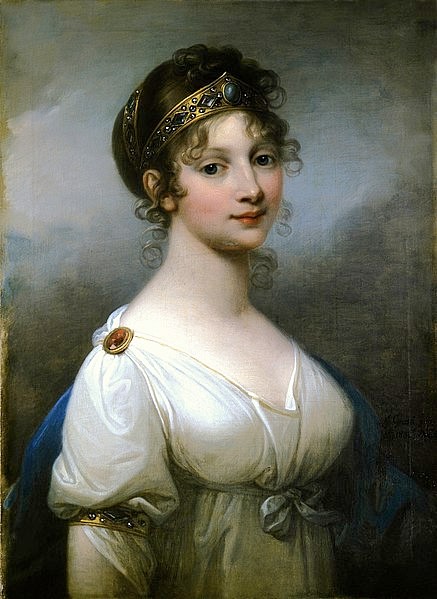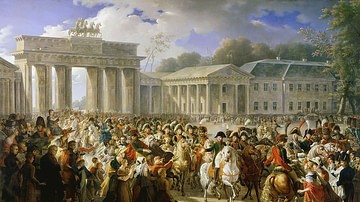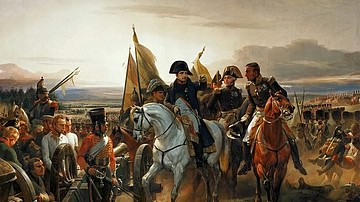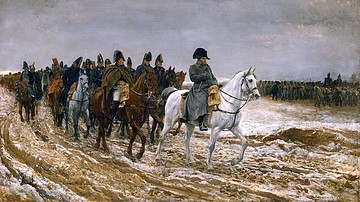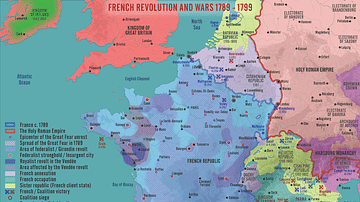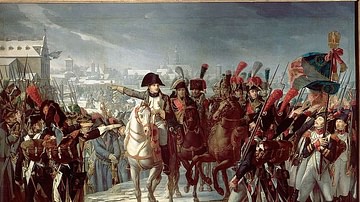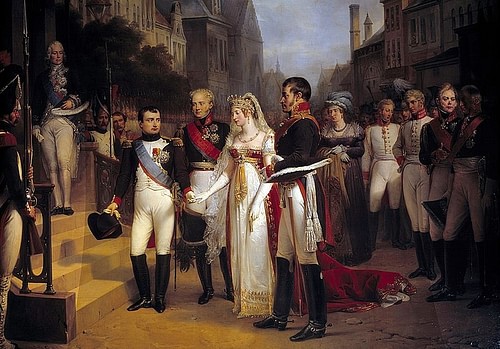
The Treaties of Tilsit were two peace treaties signed in July 1807 by Emperor Napoleon I of France (r. 1804-1814; 1815) and the monarchs of Russia and Prussia in the aftermath of the Battle of Friedland. The treaties ended the War of the Fourth Coalition, solidified French control of Central Europe at Prussia's expense, and turned Russia into a Napoleonic ally.
Following a long and bloody campaign in Poland, Napoleon's Grande Armée was finally able to decisively defeat the Russian army on 14 June 1807 at Friedland. After an armistice was signed, Napoleon met with Tsar Alexander I of Russia (r. 1801-1825) on a raft in the middle of the Niemen (Neman) River, where the two emperors discussed terms not only for peace but for a Franco-Russian alliance. This first treaty was signed between Napoleon and Alexander on 7 July and granted Russia favorable terms; the second treaty, signed on 9 July with King Frederick William III of Prussia (r. 1797-1840), was much harsher. Despite the impassioned pleas of Queen Louise of Prussia, Napoleon forced the Prussians to cede nearly half of their pre-war territories, out of which he established the Kingdom of Westphalia and the Grand Duchy of Warsaw as French client states.
The Treaties of Tilsit ensured that most of continental Europe was under Napoleon's control, either directly or through indirect means such as alliances and client states. France had become merely the center of a "Grand Empire", a political entity that nearly spanned the breadth of Europe. Tilsit, therefore, was arguably the moment when Napoleon's power reached its zenith.
Background: The Conquest of Europe
The Napoleonic Wars are generally said to have begun in May 1803, when the brittle peace between France and the United Kingdom was shattered and the two nations went back to war. As Napoleon began to build up an army for a planned invasion of England, the British organized the great powers of Europe into a third anti-French coalition, which was joined by Austria, Russia, Sweden, Naples, and Sicily. As the Third Coalition mobilized its armies in the summer of 1805, Napoleon did not hesitate to strike. Abandoning his planned invasion of Britain, he marched his 210,000-man army – rechristened as La Grande Armée – across the Rhine and eliminated an Austrian army in the Ulm Campaign (25 September to 20 October 1805), before shattering an Austro-Russian force in the brilliant Battle of Austerlitz (2 December). While the broken Russian army limped back to Hungary, Austria decided to surrender, and the War of the Third Coalition came to an end.
In the aftermath of his victory, Napoleon reshaped the map of Europe. He dethroned the Neapolitan House of Bourbon and gave the throne of Naples to his brother, Joseph Bonaparte. Napoleon also created the Confederation of the Rhine, a league of German states under the protection of France. Membership in the confederation required these states to exit the Holy Roman Empire, directly resulting in the empire's dissolution in July 1806. France's newfound influence in Central Europe threatened Prussia, which clamored for war; a war party formed around Queen Louise of Prussia, while Prussian officers provocatively sharpened their sabers on the steps of the French Embassy in Berlin. In October 1806, King Frederick William III gave in to his wife's pressure and declared war on France, joining Russia and Britain in the War of the Fourth Coalition.
However, Frederick William had declared war too early and had not given the Russians enough time to move their troops in support of the Prussian army. Napoleon, who had wintered in southern Germany, quickly invaded Saxony and inflicted a crushing defeat on the Prussian army at the double Battle of Jena-Auerstedt (14 October 1806). Berlin fell less than two weeks later, forcing the Prussian court to flee to Königsberg in East Prussia (modern Kaliningrad, Russia). Napoleon next invaded Prussian-occupied Poland and entered Warsaw on 19 December, where he was hailed by the local Polish population as a liberator. Though Napoleon was careful not to make any explicit promises regarding a full restoration of Polish sovereignty, he did organize the six Polish departments under French occupation into a semi-autonomous political entity governed by a council of seven Polish nobles.
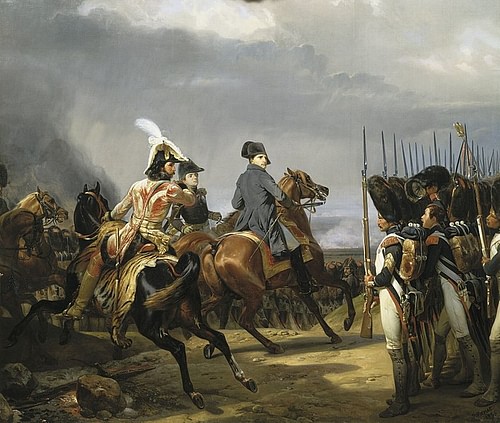
Having secured the support of Polish patriots, Napoleon ordered his Grande Armée across the Vistula River, to engage the Russian army commanded by Count Levin August von Bennigsen, a German-born officer serving the Russian tsar. This Polish campaign culminated in the bloody but inconclusive Battle of Eylau, fought on 7-8 February 1807 amidst a snowstorm. Though each side lost around 25,000 casualties, neither gained much of an advantage and both armies withdrew into winter quarters in the aftermath of the battle. This marked the first time Napoleon's Grande Armée had met with anything other than complete victory, resulting in a deterioration of morale. Upon emerging from winter quarters four months later, Napoleon and Bennigsen clashed once more at the Battle of Friedland. As the French drove the Russians into the Alle River, it became clear that this was the decisive battle Napoleon had been searching for. Following his defeat, Bennigsen withdrew his army across the Niemen River. Napoleon followed, establishing his camp on the opposite bank, near the town of Tilsit (Sovetsk).
A Long-Awaited Peace
On 19 June 1807, four days after Friedland, Napoleon received Prince Dmitriy Lobanov-Rostovsky, a Russian envoy who bore a letter from Count Bennigsen asking for an armistice. It read:
After the torrents of blood which have lately flowed in battles as sanguinary as frequent, Russians desire to assuage the evils of this destructive war by proposing an armistice before we enter upon a conflict, a fresh war, perhaps more terrible than the first. (Mikaberidze, 225)
Napoleon agreed to the armistice and invited Prince Lobanov-Rostovsky to join him for dinner. After raising a toast to the health of Tsar Alexander I of Russia, Napoleon remarked that he desired friendship with the Russians and that the Vistula River marked the natural boundary between the French and Russian empires. This comment was significant since it implied that Napoleon would not demand any Russian territory if peace could be made in a timely fashion. Though Napoleon certainly had the military resources to continue the war, he was aware of the demoralization of his army and knew that an invasion of Russia would be long and costly. Furthermore, the French emperor was eager to commit his full efforts towards the defeat of Britain, which he considered to be his true enemy; in this goal, Russia would serve him more usefully as an ally than an enemy. Napoleon desired for Russia to join his Continental System, a Europe-wide blockade of British goods, which the emperor saw as the only way that France could force Britain to its knees.
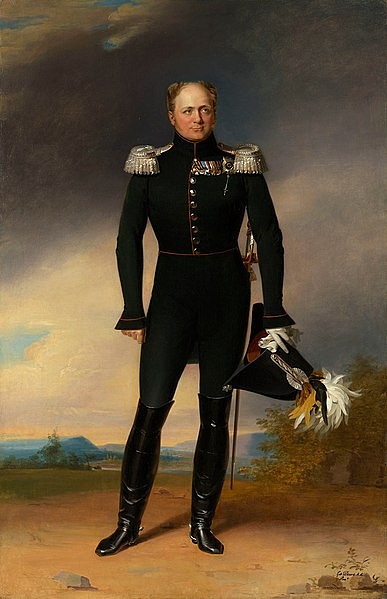
Tsar Alexander, meanwhile, was also eager to make peace. After months of bloody campaigning against both Napoleon and the Ottoman Empire, Alexander welcomed a respite from the fighting so he could replenish his battered military. Additionally, the tsar was concerned that a French invasion of Russian territory could incite his Polish subjects to revolt. But Alexander's decision to make peace was also partly made because he felt that Britain had left the Russian army to bear the brunt of the fighting and that the British were more interested in securing their colonial interests than they were in defeating Napoleon. Feeling both betrayed and used, the tsar was no longer willing to fight on his own and left St. Petersburg to personally meet with Napoleon.
Meeting of the Two Emperors
In preparation for his meeting with Alexander, Napoleon ordered a giant raft to be built in the middle of the Niemen River, tethered to both riverbanks. An ornate pavilion was erected on the raft, the doors of which were decorated with the imperial eagles of both France and Russia. On 25 June 1807, both emperors were rowed out to the raft, accompanied by their retinues. Napoleon, who made it to the raft first, embraced the Russian tsar as he stepped off his boat. Apparently, Tsar Alexander greeted Napoleon with the words, "Sire, I hate the English as much as you do," to which the French emperor responded, "In that case, peace is made" (Mikaberidze, 225).
The two emperors then entered the privacy of the pavilion, where they sat conversing for the next two hours. French and Russian soldiers lined each bank of the Niemen, watching anxiously, likely wondering if an agreement would be reached. No less anxious was King Frederick William III of Prussia, who had not been invited onto the raft and was left to helplessly ride his horse up and down the riverbank as the emperors of France and Russia decided the fate of his kingdom. It was not until the next day that Frederick William was invited on the raft, almost as an afterthought. At the end of this second meeting, Tsar Alexander was rowed to the French side of the river and entered the town of Tilsit. He was greeted by a 100-gun salute, was escorted about town by Napoleon personally, and was put up in the finest mansion in Tilsit. By contrast, Frederick William received no such salute, was snubbed by Napoleon, and was put up in the house of a miller.
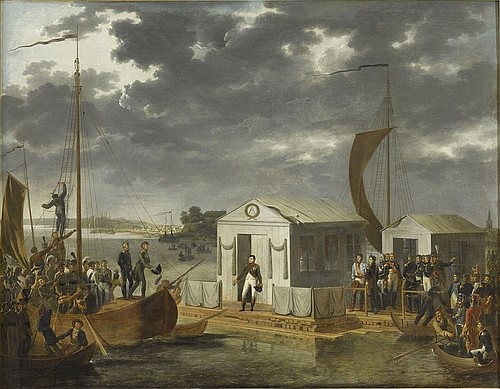
Napoleon and Alexander got on well with each other. They held banquets in one another's honor and reviewed each other's troops, with Napoleon even awarding a Russian grenadier the Legion of Honor. In a letter to his wife Joséphine, Napoleon described the 29-year-old tsar as "a very handsome and good young emperor; he has more intelligence than one thinks" (Roberts, 457). Alexander, likewise, was impressed with Napoleon, with whom he would converse for hours at a time. They discussed politics, their mutual hatred for Britain, and the terms of a potential alliance, but also talked at length about philosophy. Historian Andrew Roberts recounts an interesting conversation where the two emperors discussed the best form of government; Tsar Alexander, the absolute monarch, curiously argued in favor of an elective monarchy while Napoleon, whose authority was supposed to have been confirmed by a plebiscite, argued for autocracy (Roberts, 458). The warmness and mutual flattery the emperors heaped on one another was not extended to Frederick William; both emperors considered the Prussian king to be a bore, and they tolerated his presence only so far as they had to.
The First Treaty: 7 July
After several days of discussion, the Franco-Russian treaty was finally signed on 7 July 1807. Although it certainly favored the interests of France over those of Russia, the Russians made out surprisingly well, considering that they were the vanquished nation. Most of the concessions that Tsar Alexander agreed to were made at the expense of Prussia, with Russia losing no territory of its own except for the Ionian Islands. The terms of the first Treaty of Tilsit included:
- A formal alliance between the French and Russian Empires.
- Russia's recognition of the Confederation of the Rhine under French protection.
- Danzig (Gdańsk), previously part of Prussia, was to become a free city.
- Russia's recognition of the Kingdom of Westphalia as a French client state, with Napoleon's youngest brother, Jérôme Bonaparte, as its king.
- Russia's recognition of the Grand Duchy of Warsaw, organized from Prussia's Polish territories. Napoleon's ally, King Frederick Augustus of Saxony, was recognized as its ruler.
- Alexander pledged to mediate a peace between Britain and France and to go to war with Britain if such talks failed, and Napoleon pledged to do the same for Russia and the Ottoman Empire.
- Russia would join the Continental System and force Denmark and Sweden to close their ports to British trade.
- Napoleon gave his blessing for Russia to invade and occupy Finland, currently held by Sweden.
In summary, although Russia was forced to join the Continental System and recognize a potentially dangerous political entity in Poland, the first Treaty of Tilsit essentially divided Europe into French and Russian spheres of influence. As the icing on the cake, Napoleon gifted Alexander the eastern part of Bialystock, which had been part of Prussian-occupied Poland. But it was clear that, despite the masquerade of friendship, Alexander had not forgotten who his true enemy was. As he prepared to return to St. Petersburg, Alexander bid farewell to Frederick William, his erstwhile ally. Leaning in close, the tsar promised the Prussian king that Napoleon “will break his neck. Despite all my performance and external behavior I am your friend and hope to prove that to you by my actions” (Lieven, 53).
The Second Treaty: 9 July 1807
On 6 July, three days before the second treaty with Prussia was to be signed, Queen Louise of Prussia arrived in Tilsit. In a two-hour conference with Napoleon, Louise pleaded with the French emperor to have mercy on her country and asked that Prussia at least be allowed to keep Magdeburg on the west bank of the Elbe. At 35 years old, Queen Louise was famed for her beauty, which she tactfully utilized to complement her political cunning; with her feminine charm, she hoped to stir Napoleon's sympathies so that he would let her keep Magdeburg despite its strategic importance. However, Napoleon remained unmoved by her tears. "She believes I came all this way for her nice eyes," he scoffed to his chief of staff.
The city of Magdeburg instead became part of the newly created Kingdom of Westphalia, formed from the territories of Brunswick and Hesse-Kassel. Since Napoleon had soundly defeated the Prussian army at Jena-Auerstedt and occupied the Prussian capital of Berlin, he was under no obligation to treat Prussia with as much leniency as he had shown Russia. Indeed, he implemented harsh terms which, aside from the loss of Magdeburg, included:
- Prussia had to cede all its lands west of the Elbe River and accept all territorial changes agreed to in the first treaty, which meant accepting the loss of Danzig and all its Polish territories.
- Prussia's recognition of the Confederation of the Rhine, which was tantamount to accepting French hegemony in Germany.
- Prussia had to enter a military alliance with France.
- The strength of the Prussian army was reduced to no more than 42,000 men for a ten-year period, with the recruitment of additional militias prohibited.
- Prussia had to join the Continental System.
- Prussia had to pay a war indemnity of 140 million francs.
At the stroke of a pen, Prussia was practically reduced to a second-rate power. Its territory was slashed from 230,000 km² (89,000 mi²) before the war, to a little over 120,000 km² (46,000 mi²); it went from a pre-war population of 9.75 million to only 4.5 million that remained within Prussia's new borders. The harsh terms of the treaty guaranteed that Napoleon had earned the lasting hatred of Prussia, but the French emperor did not care; so long as his alliance with Russia endured, there was nothing the Prussians could do. Indeed, the Treaties of Tilsit ensured that Prussia would not threaten Napoleon again for the next six years, until the War of the Sixth Coalition in 1813.
Significance
The Treaties of Tilsit arguably marked the apogee of Napoleon's power. According to Napoleon himself, looking back on his career from his exile on St. Helena, Tilsit also marked the happiest period of his life. "I had just surmounted many vicissitudes, many anxieties," he would explain. "And I found myself victorious, dictating laws, having emperors and kings pay me court" (Roberts, 460). It must have been quite the experience for a man who, just 15 years before, had been an unknown Corsican national looking to make a name for himself in the French army.
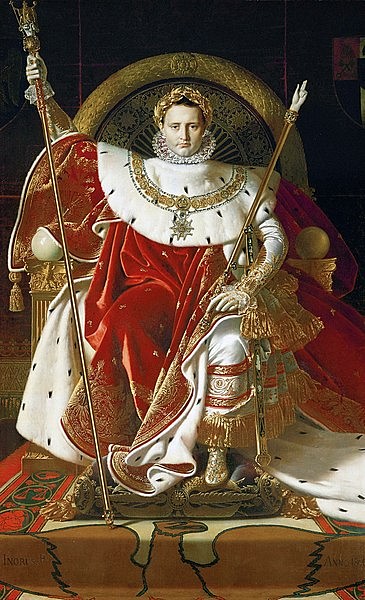
But Napoleon's power (and his moment of happiness if he was telling the truth) would not last for long. Only months after Tilsit, Napoleon would launch an invasion first of Portugal, then of Spain; the resulting Peninsular War (1807-1814) would drain his empire of sorely needed troops and help bring about his downfall. His alliance with Russia would not even last five years; relations between the two emperors would deteriorate, leading to Napoleon's ill-fated invasion of Russia in 1812. The subsequent War of the Sixth Coalition (1813-1814) would see Prussia once again throw its lot in with Napoleon's enemies, and would result in Napoleon's first abdication and exile to Elba. Though the Treaties of Tilsit would not last, they are nonetheless an example of the political prowess Napoleon once wielded, a look at the First French Empire at its peak.
